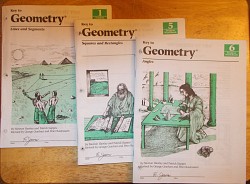Key to Geometry
Several years ago we came across a publisher called Key Curriculum Press. They publish curricula on a variety of math topics, including a series of non-intimidating, inexpensive, 55 page books. The topics include measurement, metric measurement, fractions, decimals, percent, algebra, and geometry. For the link, simply search for Key Curriculum Press.
We used the algebra series for a few students who needed a “softer” approach, but we used the geometry for everyone. Never had I experienced children asking for more math homework, but that is what happened with the geometry series, called Key To Geometry.
This is not the geometry you had in high school. This is the geometry that Archimedes, Euclide, and other ancient Greek mathematicians, experienced. The whole series is based on what might be called a “guided discovery” approach. It is a construction approach, not a proof approach. The children are never asked to prove anything, but are beautifully guided to experience and discover the principles of geometry by using three tools: 1) a pencil, 2) a compass, (not the directional one, but a tool for making circles, or parts of a circle), 3) a straight edge, (a straight piece of wood or metal without any measurement markings). After experimenting with a few different styles of compasses, we realized that the simple compasses from Key Curriculum were the best.
Our students loved it, and I am serious about them asking for more. When our students took high school geometry, they always excelled because of their experience in Key to Geometry. If you never understood geometry, get a set of books for yourself, as well as your children and work through the books together.
The first six books are 55 pages long and cover:
1- Lines and Segments
2- Circles
3- Constructions
4- Perpendiculars
5- Squares and Rectangles
6- Angles
The last two books are about 150 pages long and cover:
7- Perpendiculars and Parallels, Chords and Tangents, Circles
8- Triangles, Parallel Lines, Similar Polygons
We started our students with book one in fourth grade. By the time they had finished the eighth grade, they had completed the series. Geometry was not actually a main topic of study, but the children loved this course so much that we found a way of working it into the schedule.
Each book includes a “Practice Test”, but the students found the tests too easy. Actually, they were a bit insulted because the tests were so easy. In response we made up our own tests which were more challenging. If anyone is inspired to use this curriculum and is interested in these tests, simply contact us at jkhughes@stmichaelschool.us and we will send them to you, at no charge, as PDF files.
 Orthodoxy in America.org
Orthodoxy in America.org